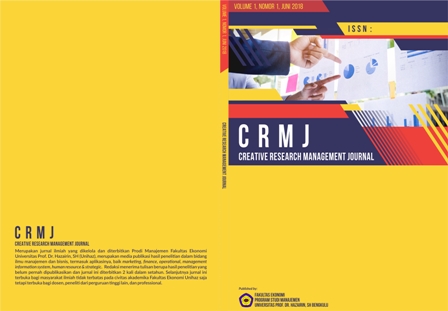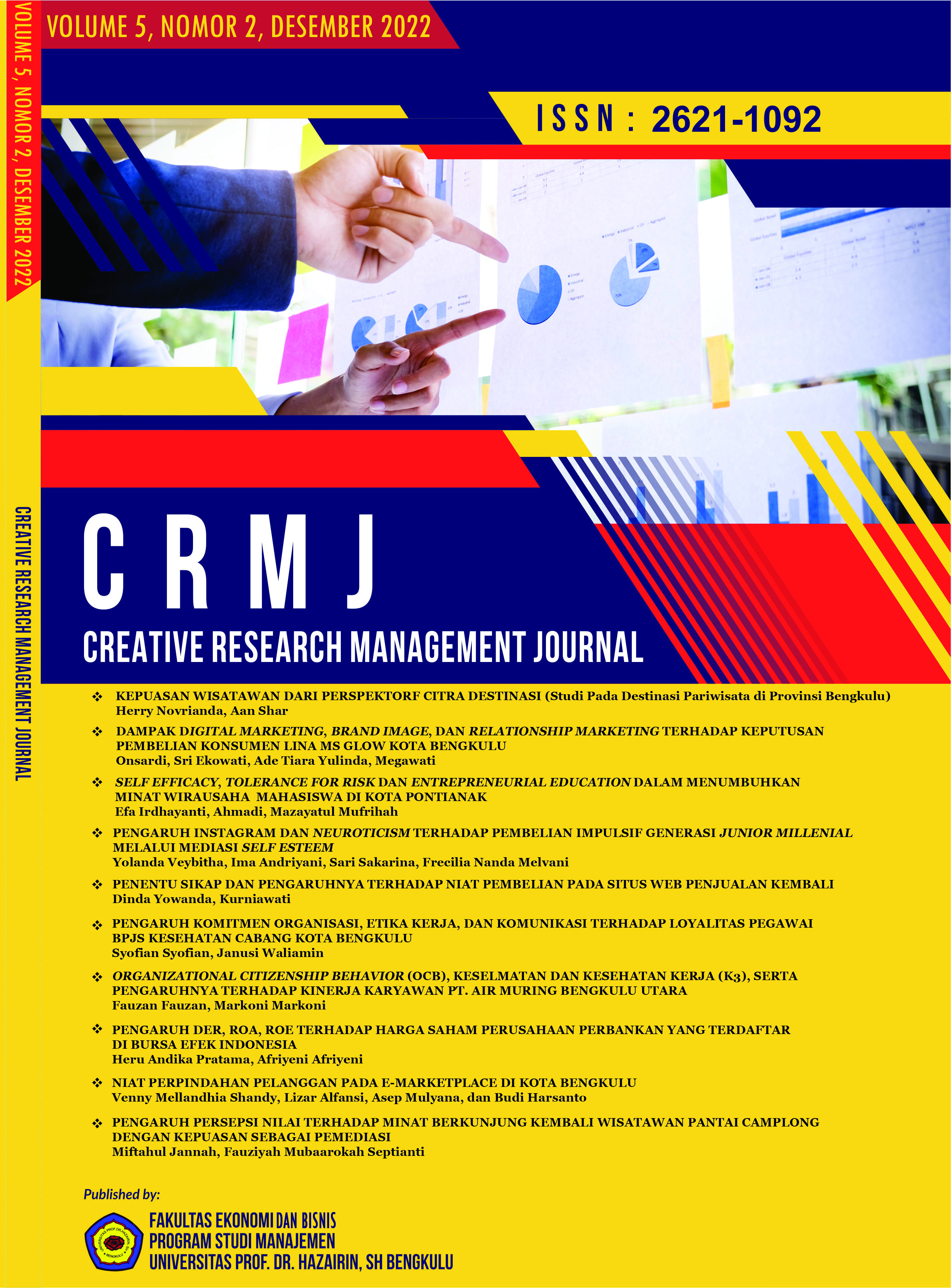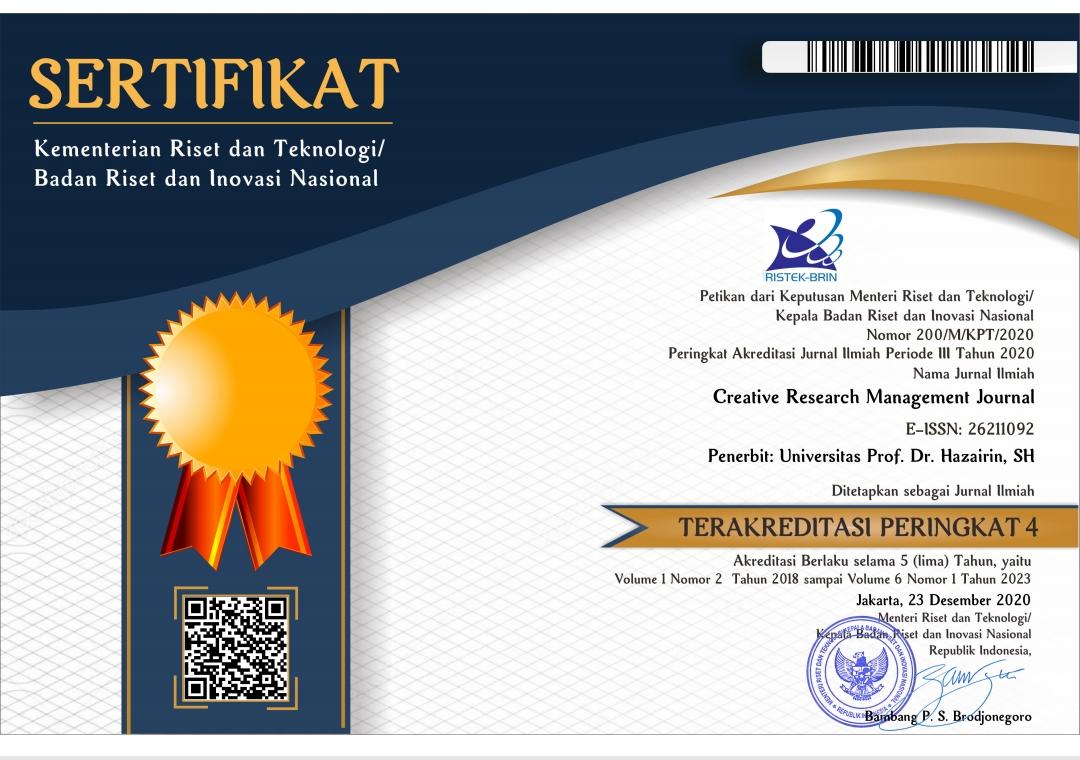NIAT PERPINDAHAN PELANGGAN PADA E-MARKETPLACE DI KOTA BENGKULU
DOI:
https://doi.org/10.32663/crmj.v5i2.3088Kata Kunci:
Price Fairness, Relationship Quality, Perceived Betrayal, Switching IntentionAbstrak
This study aims to examine and analyze whether there is an influence between price fairness, relationship quality, perceived betrayal on switching intentions. This research uses Partial Least Square Structural Equation Model (SEM PLS). The method used in this study is non-probability sampling. The population used in this study are consumers who have transacted in e-marketplaces and moved to other e-marketplaces in Bengkulu city and 353 samples were selected. The results showed that price fairness had a negative effect on the perception of betrayal, the quality of the relationship had a negative effect on the perception of betrayal, price fairness had a positive effect on the relationship, the perception of betrayal had a positive effect on switching intention, price fairness had a negative effect on switching intentions, and the quality of the relationship had no negative effect. on switching intentions. Even though the quality of the relationship with customers is good, customers can still intend to switch to other e-marketplaces. For further research, the authors suggest examining other factors that may influence the relationship, such as alternative product offerings, prices, promotions, discounts, and others so that this research will be more extensive.
Referensi
Andrés?martínez, M. E., Gómez?borja, M. Á., & Mondéjar?jiménez, J. A. (2013). A review of the price fairness perception concept. Academia Revista Latinoamericana de Administración, 26(4), 318–342. https://doi.org/10.1108/ARLA-06-2013-0067/FULL/HTML
Andrés-Martínez, M. E., Gómez-Borja, M. Á., & Mondéjar-Jiménez, J. A. (2014). A model to evaluate the effects of price fairness perception in online hotel booking. Electronic Commerce Research, 14(2), 171–187. https://doi.org/10.1007/S10660-014-9137-4
Auh, S., & Shih, C. F. (2005). The Relative Effects of Relationship Quality and Exchange Satisfaction on Customer Loyalty. Journal of Business-to-Business Marketing, 12(2), 73–100. https://doi.org/10.1300/J033V12N02_03
Baumann, J., & le Meunier-FitzHugh, K. (2014). Trust as a facilitator of co-creation in customer-salesperson interaction – An imperative for the realization of episodic and relational value? AMS Review, 4(1), 5–20. https://doi.org/10.1007/S13162-013-0039-8
Bhattacharya, A., & Friedman, H. H. (2001). Using “smart” pricing to increase profits and maximize customer satisfaction. National Public Accountant, 46(6), 34–38. https://papers.ssrn.com/sol3/papers.cfm?abstract_id=2336277
Bolton, L., Warlop, L., & Alba, J. W. (2003). Consumer perceptions of price (un)fairness. Journal of Consumer Research, 29(4), 474–491. https://doi.org/10.1086/346244
Caceres, R. C., & Paparoidamis, N. G. (2007). Service quality, relationship satisfaction, trust, commitment and business-to-business loyalty. European Journal of Marketing, 41(7–8), 836–867. https://doi.org/10.1108/03090560710752429/FULL/HTML
Cai, R., Lu, L., & Gursoy, D. (2018). Effect of disruptive customer behaviors on others’ overall service experience: An appraisal theory perspective. Tourism Management, 69, 330–344. https://www.sciencedirect.com/science/article/pii/S0261517718301249
Choi, S., & Mattila, A. S. (2009). Perceived fairness of price differences across channels: The moderating role of price frame and norm perceptions. Journal of Marketing Theory and Practice, 17(1), 37–48. https://doi.org/10.2753/MTP1069-6679170103
Chu, Z., & Wang, Q. (2012). Drivers of relationship quality in logistics outsourcing in China. Journal of Supply Chain Management, 48(3), 78–96. https://doi.org/10.1111/j.1745-493X.2011.03259.x
Daskalopoulou, I. (2008). Fairness perceptions and observed consumer behavior: Results of a partial observability model. The Journal of Socio-Economics, 37(1), 31–44. https://www.sciencedirect.com/science/article/pii/S1053535707000042
de Wulf, K., Odekerken-Schröder, G., & Iacobucci, D. (2001). Investments in consumer relationships: A cross-country and cross-industry exploration. Journal of Marketing, 65(4), 33–50. https://doi.org/10.1509/JMKG.65.4.33.18386
Ennew, C. T., & Binks, M. R. (1996). The impact of service quality and service characteristics on customer retention: Small businesses and their banks in the UK. British Journal of Management, 7(3), 219–230. https://doi.org/10.1111/J.1467-8551.1996.TB00116.X
Feinberg, F. M., Krishna, A., & Zhang, Z. J. (2002). Do we care what others get? A behaviorist approach to targeted promotions. Journal of Marketing Research, 39(3), 277–291. https://doi.org/10.1509/JMKR.39.3.277.19108
Ferguson, J., Ellen, P., & Bearden, W. O. (2014). Procedural and distributive fairness: Determinants of overall price fairness. Journal of Business Ethics, 121(2), 217–231. https://doi.org/10.1007/s10551-013-1694-2
Fitness, J. (2001). Betrayal, rejection, revenge, and forgiveness: An interpersonal script approach. Interpersonal Rejection, 73–103. http://www.psych.purdue.edu/~willia55/392F-’06/FitnessBetrayal.pdf
Ganesh, J., Arnold, M. J., & Reynolds, K. E. (2000). Understanding the customer base of service providers: An examination of the differences between switchers and stayers. Journal of Marketing, 64(3), 65–87. https://doi.org/10.1509/JMKG.64.3.65.18028
Garbarino, E., & Johnson, M. S. (1999). The Different Roles of Satisfaction, Trust, and Commitment in Customer Relationships. Journal of Marketing, 63(2), 70–87. https://doi.org/10.1177/002224299906300205
Geyskens, I., Steenkamp, J. B. E., Scheer, L. K., & Kumar, N. (1996). The effects of trust and interdependence on relationship commitment: A trans-Atlantic study. International Journal of Research in Marketing, 13(4), 303–317. https://doi.org/10.1016/S0167-8116(96)00006-7
Gielissen, R., Dutilh, C. E., & Graafland, J. J. (2008). Perceptions of price fairness: An empirical research. Business and Society, 47(3), 370–389. https://doi.org/10.1177/0007650308316937
Grace, D., & O’Cass, A. (2001). Attributions of service switching: A study of consumers’ and providers’ perceptions of child-care service delivery. Journal of Services Marketing, 15(4), 300–321. https://doi.org/10.1108/EUM0000000005508/FULL/
Grégoire, Y., Tripp, T. M., & Legoux, R. (2009). When customer love turns into lasting hate: The effects of relationship strength and time on customer revenge and avoidance. Journal of Marketing, 73(6), 18–32. https://doi.org/10.1509/JMKG.73.6.18
Hair, J. F., Black, W. C., Babin, B. J., & Anderson, R. E. (2010). Multivariate data analysis: A global perspective. Pearson Education. https://scholar.google.com/scholar?hl=en&as_sdt=0%2C5&q=Multivariate+Data+Analysis+A+Global+Perspective+hair&btnG=#d=gs_cit&t=1663127488232&u=%2Fscholar%3Fq%3Dinfo%3AE7AHDFOkaR4J%3Ascholar.google.com%2F%26output%3Dcite%26scirp%3D0%26hl%3Den
Han, H., Hsu, L., & Lee, J. (2009). Empirical investigation of the roles of attitudes toward green behaviors, overall image, gender, and age in hotel customers’ eco-friendly decision-making process. International Journal of Hospitality Management, 28(4), 519–528. https://www.sciencedirect.com/science/article/pii/S0278431909000309
Han, H., & Hyun, S. S. (2013). Image congruence and relationship quality in predicting switching intention: Conspicuousness of product use as a moderator variable. Journal of Hospitality & Tourism Research, 37(3), 303–329. https://doi.org/10.1177/1096348012436381
Homburg, C., Hoyer, W. D., & Koschate, N. (2005). Customers’ reactions to price increases: Do customer satisfaction and perceived motive fairness matter? Journal of the Academy of Marketing Science, 33(1), 36–49. https://doi.org/10.1177/0092070304269953
iprice. (2019). Peta E Commerce Indonesia. Iprice.Co.Id. https://iprice.co.id/insights/mapofecommerce/
Jin, N., Line, N., & Goh, B. (2013). Experiential value, relationship quality, and customer loyalty in full-service restaurants: The moderating role of gender. Journal of Hospitality Marketing & Management, 22(7), 679–700. https://doi.org/10.1080/19368623.2013.723799
Kahn, B. E. (1995). Consumer variety-seeking among goods and services: An integrative review. Journal of Retailing and Consumer Services, 2(3), 139–148. https://doi.org/10.1016/0969-6989(95)00038-0
Kannan, P. K., & Kopalle, P. K. (2001). Dynamic pricing on the Internet: Importance and implications for consumer behavior. International Journal of Electronic Commerce, 5(3), 63–83. https://doi.org/10.1080/10864415.2001.11044211
Kim, W. G., Lee, Y. K., & Yoo, Y. J. (2006). Predictors of Relationship Quality and Relationship Outcomes in Luxury Restaurants. Journal of Hospitality and Tourism Research, 30(2), 143–169. https://doi.org/10.1177/1096348005285086
Lee, J., Pan, S., & Tsai, H. (2013). Examining perceived betrayal, desire for revenge and avoidance, and the moderating effect of relational benefits. International Journal of Hospitality Management, 32, 80–90. https://www.sciencedirect.com/science/article/pii/S027843191200059X
Leonidou, L., Aykol, B., Fotiadis, T. A., Christodoulides, P., & Zeriti, A. (2017). Betrayal in international buyer-seller relationships: Its drivers and performance implications. Journal of World Business, 52(1), 28–44. https://www.sciencedirect.com/science/article/pii/S1090951616301572
Lin, T., Cheng, H., Wang, F., & Chang, K. J. (2012). A study of online auction sellers’ intention to switch platform: The case of Yahoo! Kimo versus Ruten_eBay. Decision Sciences, 43(2), 241–272. https://doi.org/10.1111/j.1540-5915.2011.00347.x
Martín?Consuegra, D., Molina, A., & Esteban, A. (2007). An integrated model of price, satisfaction and loyalty: An empirical analysis in the service sector. Journal of Product & Brand Management. https://www.emerald.com/insight/content/doi/10.1108/10610420710834913/full/html
Mohammad, H., Ali, D., Afshin, R., & Ali, H. (2012). Evaluation of factors affecting customer loyalty in the restaurant industry. African Journal of Business Management, 6(14), 5039–5046. https://doi.org/10.5897/AJBM11.2765
Morgan, R. M., & Hunt, S. D. (1994). The Commitment-Trust Theory of Relationship Marketing. Journal of Marketing, 58(3), 20–38. https://doi.org/10.1177/002224299405800302
Namkung, Y., & Jang, S. C. (2010). Effects of perceived service fairness on emotions, and behavioral intentions in restaurants. European Journal of Marketing, 44(9), 1233–1259. https://doi.org/10.1108/03090561011062826/FULL/HTML
Ndubisi, N. O., Lee, C. H., & Eze, U. C. (2011). Analyzing key determinants of online repurchase intentions. Asia Pacific Journal of Marketing and Logistics, 23(2), 200–221. https://doi.org/10.1108/13555851111120498/FULL/HTML
Nikbin, D., Marimuthu, M., & Hyun, S. S. (2013). Influence of perceived service fairness on relationship quality and switching intention: An empirical study of restaurant experiences. Current Issues in Tourism, 19(10), 1005–1026. https://doi.org/10.1080/13683500.2013.801407
Noone, B. M., & Mount, D. J. (2008). The effect of price on return intentions: Do satisfaction and reward programme membership matter? Journal of Revenue and Pricing Management, 7(4), 357–369. https://doi.org/10.1057/RPM.2008.21
Nyaga, G. N., & Whipple, J. M. (2011). Relationship quality and performance outcomes: Achieving a sustainable competitive advantage. Journal of Business Logistics, 32(4), 345–360. https://doi.org/10.1111/J.0000-0000.2011.01030.X
Oh, H. (2000). The Effect of Brand Class, Brand Awareness, and Price on Customer Value and Behavioral Intentions. Journal of Hospitality and Tourism Research, 24(2), 136–162. https://doi.org/10.1177/109634800002400202
Rachman, S. (2010). Betrayal: A psychological analysis. Behaviour Research and Therapy, 48(4), 304–311. https://www.sciencedirect.com/science/article/pii/S0005796709002848
Rahmani-Nejad, L., Firoozbakht, Z., & Taghipoor, A. (2014). Service quality, relationship quality and customer loyalty (Case study: Banking industry in Iran). Open Journal of Social Sciences, 2(4), 262. https://www.scirp.org/html/12-1760089_44470.htm?pagespeed=noscript
Reichheld, F., & Sasser, W. E. (1990). Zero defeo?ons: Quoliiy comes to services. Harvard Business Review, 68(5), 105–111. http://matlesiouxx.free.fr/Cours/HKU/Courses/CSIS0404/Lecture%201/Module1_3_Zero_Defections_-Quality_Comes_to_Services.pdf
Reimann, M., Macinnis, D. J., Folkes, V. S., Uhalde, A., & Pol, G. (2018). Insights into the experience of brand betrayal: From what people say and what the brain reveals. Journal of the Association for Consumer Research, 3(2), 240–254. https://doi.org/10.1086/697077
Reina, D. S., & Reina, M. L. (2006). Trust and Betrayal in The Workplace: Building Effective Relationships in Your Organization. CA: Berrett-Koehler Publishers.
Sargeant, A., & Lee, S. (2004). Donor trust and relationship commitment in the UK charity sector: The impact on behavior. Nonprofit and Voluntary Sector Quarterly, 33(2), 185–202. https://doi.org/10.1177/0899764004263321
Shehryar, O., & Hunt, D. M. (2005). Buyer behavior and procedural fairness in pricing: Exploring the moderating role of product familiarity. Journal of Product and Brand Management, 14(4), 271–276. https://doi.org/10.1108/10610420510609294/FULL/HTML
Spekman, R. E. (1988). Strategic supplier selection: Understanding long-term buyer relationships. Business Horizons, 31(4), 75–81. https://www.sciencedirect.com/science/article/pii/0007681388900729
Thaichon, P., & Quach, T. N. (2016). Integrated Marketing Communications and Their Effects on Customer Switching Intention. Journal of Relationship Marketing, 15(1–2), 1–16. https://doi.org/10.1080/15332667.2014.965647
Tsai, D., & Lee, H. C. (2007). Will you care when you pay more? The negative side of targeted promotions. Journal of Product and Brand Management, 16(7), 481–491. https://doi.org/10.1108/10610420710834931/FULL/HTML
Tsao, W. C., & Hsieh, M. T. (2012). Exploring how relationship quality influences positive eWOM: The importance of customer commitment. Total Quality Management and Business Excellence, 23(7–8), 821–835. https://doi.org/10.1080/14783363.2012.661137
Vlachos, P., Tsamakos, A., Vrechopoulos, A. P., & Avramidis, P. K. (2009). Corporate social responsibility: Attributions, loyalty, and the mediating role of trust. Journal of the Academy of Marketing Science, 37(2), 170–180. https://doi.org/10.1007/s11747-008-0117-x
Wang, S., & Archer, N. P. (2007). Electronic marketplace definition and classification: Literature review and clarifications. Enterprise Information Systems, 1(1), 89–112. https://doi.org/10.1080/17517570601088380
Weisstein, F., Monroe, K., & Kukar-Kinney, M. (2013). Effects of price framing on consumers’ perceptions of online dynamic pricing practices. Journal of the Academy of Marketing Science, 41(5), 501–514. https://doi.org/10.1007/s11747-013-0330-0
Whitten, D., & Leidner, D. (2006). Bringing IT back: An analysis of the decision to backsource or switch vendors. Decision Sciences, 37(4), 605–621. https://doi.org/10.1111/J.1540-5414.2006.00140.X
Xia, L., Monroe, K. B., & Cox, J. L. (2004). The price is unfair! A conceptual framework of price fairness perceptions. Journal of Marketing, 68(4), 1–15. https://doi.org/10.1509/JMKG.68.4.1.42733
Zhang, K., Cheung, C., & Lee, M. K. (2012). Online service switching behavior: The case of blog service providers. Journal of Electronic Commerce Research, 13(3), 184. http://ojs.jecr.org/jecr/sites/default/files/13_3_p01.pdf














